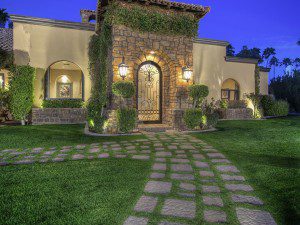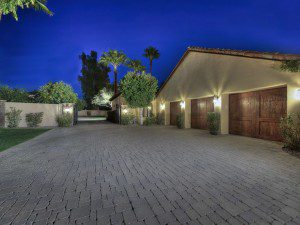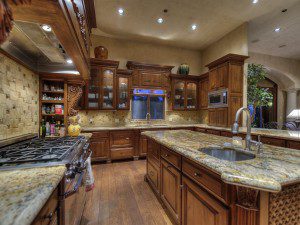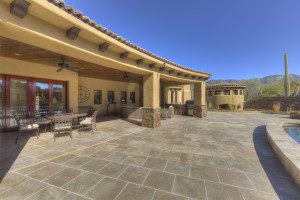1. Embrace natural light

Create the feel of windows with large mirrors. Photo via Laurel & Wolf.
Scottsdale Real Estate and Arizona Luxury Homes brought to you by the Scottsdale Real Estate Team
Search Scottsdale real estate and Paradise Valley real estate, MLS homes and condos for sale. Find the latest market data to help with your property search. Specializing in luxury homes, golf properties, condos and more.
March 25, 2016 Joe Szabo

Create the feel of windows with large mirrors. Photo via Laurel & Wolf.
March 22, 2016 Joe Szabo
 By Joe Szabo, Scottsdale Real Estate Team
Other sellers in your area are dressing up the lawn with little flowerbeds and a good trim, but why settle? Follow these five tips to set your home apart from the competition.
By Joe Szabo, Scottsdale Real Estate Team
Other sellers in your area are dressing up the lawn with little flowerbeds and a good trim, but why settle? Follow these five tips to set your home apart from the competition.
March 18, 2016 Joe Szabo
 By Joe Szabo, Scottsdale Real Estate Team
Let’s face it, first impressions matter. We care about how we dress for a job interview, and we spent extra time in front of the mirror before that first date. When it comes to selling a home, first impressions matter, too.
The term “curb appeal” derives from real estate sales and home design. For years, buyers have formed their first impressions of homes while standing in the street or sitting inside the car, just beyond the curb. Before the advent of text messaging and smartphones, a buyer would get a phone call or fax from their agent about a new listing. The initial drive-by would determine whether or not they would go for an actual showing.
To get that buyer in the door, the seller spent hours, even days, seeding new grass and planting flowers, painting their front door, mulching, weeding and cleaning up the yard. If the home didn’t appeal from the curb, buyers moved on to the next house. Curb appeal was always the single most important piece of the home sale puzzle.
By Joe Szabo, Scottsdale Real Estate Team
Let’s face it, first impressions matter. We care about how we dress for a job interview, and we spent extra time in front of the mirror before that first date. When it comes to selling a home, first impressions matter, too.
The term “curb appeal” derives from real estate sales and home design. For years, buyers have formed their first impressions of homes while standing in the street or sitting inside the car, just beyond the curb. Before the advent of text messaging and smartphones, a buyer would get a phone call or fax from their agent about a new listing. The initial drive-by would determine whether or not they would go for an actual showing.
To get that buyer in the door, the seller spent hours, even days, seeding new grass and planting flowers, painting their front door, mulching, weeding and cleaning up the yard. If the home didn’t appeal from the curb, buyers moved on to the next house. Curb appeal was always the single most important piece of the home sale puzzle.
March 15, 2016 Joe Szabo
 Please note that this Scottsdale Real Estate Blog is for informational purposes and not intended to take the place of a licensed Scottsdale Real Estate Agent. The Szabo Group offers first class real estate services to clients in the Scottsdale Greater Phoenix Metropolitan Area in the buying and selling of Luxury homes in Arizona. Award winning Realtors and Re/MAX top producers and best real estate agent for Luxury Homes in Scottsdale, The Szabo group delivers experience, knowledge, dedication and proven results. Contact Joe Szabo at 480.688.2020, [email protected] or visit www.scottsdalerealestateteam.com to find out more about Scottsdale Homes for Sale and Estates for Sale in Scottsdale and to search the Scottsdale MLS for Scottsdale Home Listings.
Please note that this Scottsdale Real Estate Blog is for informational purposes and not intended to take the place of a licensed Scottsdale Real Estate Agent. The Szabo Group offers first class real estate services to clients in the Scottsdale Greater Phoenix Metropolitan Area in the buying and selling of Luxury homes in Arizona. Award winning Realtors and Re/MAX top producers and best real estate agent for Luxury Homes in Scottsdale, The Szabo group delivers experience, knowledge, dedication and proven results. Contact Joe Szabo at 480.688.2020, [email protected] or visit www.scottsdalerealestateteam.com to find out more about Scottsdale Homes for Sale and Estates for Sale in Scottsdale and to search the Scottsdale MLS for Scottsdale Home Listings.March 11, 2016 Joe Szabo
 By Joe Szabo, Scottsdale Real Estate Team
Price-conscious consumers are constantly looking for ways to snag savings. Be it a do-it-yourself bathroom backsplash or self-help legal documents, the current trend in real estate is shying away from enlisting a perceived-as-pricey professional. However, some projects are too complex, valuable, or regulated to take on as a layperson — and the result is often a frantic call to the local plumber or electrician.
In the legal realm — particularly the transfer of real estate — there are definitely times when an attorney is not necessary, and the transaction will most certainly process without the assistance of a real estate lawyer. However, certain states mandate attorney involvement (or at least prohibit non-attorney over-involvement), making it unlawful to participate in a real estate settlement without a licensed attorney presiding. And certain transactions are too complicated, costly, or stressful to go it alone.
Here are four situations when you should consult a real estate lawyer.
By Joe Szabo, Scottsdale Real Estate Team
Price-conscious consumers are constantly looking for ways to snag savings. Be it a do-it-yourself bathroom backsplash or self-help legal documents, the current trend in real estate is shying away from enlisting a perceived-as-pricey professional. However, some projects are too complex, valuable, or regulated to take on as a layperson — and the result is often a frantic call to the local plumber or electrician.
In the legal realm — particularly the transfer of real estate — there are definitely times when an attorney is not necessary, and the transaction will most certainly process without the assistance of a real estate lawyer. However, certain states mandate attorney involvement (or at least prohibit non-attorney over-involvement), making it unlawful to participate in a real estate settlement without a licensed attorney presiding. And certain transactions are too complicated, costly, or stressful to go it alone.
Here are four situations when you should consult a real estate lawyer.
March 8, 2016 Joe Szabo
 By Joe Szabo, Scottsdale Real Estate Team
Early-career home buyers tend to be light on cash, while mid-career home buyers are saving for retirement, and retiree home buyers are facing less income. Each of these life phases requires a different mortgage strategy. Here are some planning tips to help you make smart decisions, no matter where you are in life.
By Joe Szabo, Scottsdale Real Estate Team
Early-career home buyers tend to be light on cash, while mid-career home buyers are saving for retirement, and retiree home buyers are facing less income. Each of these life phases requires a different mortgage strategy. Here are some planning tips to help you make smart decisions, no matter where you are in life.
March 4, 2016 Joe Szabo
 By Joe Szabo, Scottsdale Real Estate Team
In early May, homes sell fastest and for more money, according to the newest data. This is the new magic listing window for the country’s 25 biggest metro areas.
Weather and housing market dynamics affect the exact best window to sell in different areas, and this year, a low supply of homes on the market has pushed the window later in the spring. In Zillow’s first analysis of the best time to list, homes listed between mid-March and mid-April sold fastest and for the highest price. But the decline of the number of homes on the market has increased competition, so shoppers who start looking for a home in early spring may need to look at several homes and will often still be shopping a few months later. By May, some buyers may be anxious to get settled into a new home before the next school year — and will be more willing to pay a premium to close the deal.
For sellers hoping to sell quickly and get the maximum sale price for your home, the time to list is right in the first half of May. Nationally, homes sold May 1-15 sell about 18.5 days faster and for 1 percent more than the average listing. That means an average premium of $1,700 for the seller of a median home.
Today, Zillow has launched a new tool to personalize this data for individual sellers. The new Best Time to List feature estimates how much more money a seller can make by changing the listing date on their individual home. The tool is live for 71 million off-market homes, and registered Zillow users can find it by clicking the “Sell Your Home” on the home details page for an individual home. The methodology for the analysis, originally featured in “Zillow Talk: Rewriting the Rules of Real Estate,” is detailed on Zillow Research.
Please note that this Scottsdale Real Estate Blog is for informational purposes and not intended to take the place of a licensed Scottsdale Real Estate Agent. The Szabo Group offers first class real estate services to clients in the Scottsdale Greater Phoenix Metropolitan Area in the buying and selling of Luxury homes in Arizona. Award winning Realtors and Re/MAX top producers and best real estate agent for Luxury Homes in Scottsdale, The Szabo group delivers experience, knowledge, dedication and proven results. Contact Joe Szabo at 480.688.2020, [email protected] or visit www.scottsdalerealestateteam.com to find out more about Scottsdale Homes for Sale and Estates for Sale in Scottsdale and to search the Scottsdale MLS for Scottsdale Home Listings.
By Joe Szabo, Scottsdale Real Estate Team
In early May, homes sell fastest and for more money, according to the newest data. This is the new magic listing window for the country’s 25 biggest metro areas.
Weather and housing market dynamics affect the exact best window to sell in different areas, and this year, a low supply of homes on the market has pushed the window later in the spring. In Zillow’s first analysis of the best time to list, homes listed between mid-March and mid-April sold fastest and for the highest price. But the decline of the number of homes on the market has increased competition, so shoppers who start looking for a home in early spring may need to look at several homes and will often still be shopping a few months later. By May, some buyers may be anxious to get settled into a new home before the next school year — and will be more willing to pay a premium to close the deal.
For sellers hoping to sell quickly and get the maximum sale price for your home, the time to list is right in the first half of May. Nationally, homes sold May 1-15 sell about 18.5 days faster and for 1 percent more than the average listing. That means an average premium of $1,700 for the seller of a median home.
Today, Zillow has launched a new tool to personalize this data for individual sellers. The new Best Time to List feature estimates how much more money a seller can make by changing the listing date on their individual home. The tool is live for 71 million off-market homes, and registered Zillow users can find it by clicking the “Sell Your Home” on the home details page for an individual home. The methodology for the analysis, originally featured in “Zillow Talk: Rewriting the Rules of Real Estate,” is detailed on Zillow Research.
Please note that this Scottsdale Real Estate Blog is for informational purposes and not intended to take the place of a licensed Scottsdale Real Estate Agent. The Szabo Group offers first class real estate services to clients in the Scottsdale Greater Phoenix Metropolitan Area in the buying and selling of Luxury homes in Arizona. Award winning Realtors and Re/MAX top producers and best real estate agent for Luxury Homes in Scottsdale, The Szabo group delivers experience, knowledge, dedication and proven results. Contact Joe Szabo at 480.688.2020, [email protected] or visit www.scottsdalerealestateteam.com to find out more about Scottsdale Homes for Sale and Estates for Sale in Scottsdale and to search the Scottsdale MLS for Scottsdale Home Listings.March 1, 2016 Joe Szabo
 By Joe Szabo, Scottsdale Real Estate Team
With home values rising, homeowners who have equity, a much-valued resource, might be tempted to tap some of that wealth and use it for other purposes. But depending on your personal situation and how you’d like to use the equity, it may not necessarily be the right thing to do.
Here’s when a home equity loan, which allows you to use the equity of your home as collateral, makes sense — and when it doesn’t.
By Joe Szabo, Scottsdale Real Estate Team
With home values rising, homeowners who have equity, a much-valued resource, might be tempted to tap some of that wealth and use it for other purposes. But depending on your personal situation and how you’d like to use the equity, it may not necessarily be the right thing to do.
Here’s when a home equity loan, which allows you to use the equity of your home as collateral, makes sense — and when it doesn’t.
February 26, 2016 Joe Szabo
 By Joe Szabo, Scottsdale Real Estate Team
If the kitchen is the heart of the home, its major appliances are what keep it pumping. So it’s no surprise that 46 percent of American homeowners cite the cook space as the area where they’d most likely splurge on a remodel — and 56 percent of those planning work have set their sights on new appliances, according to a recent national survey by LG Electronics.
If your last kitchen remodel was years ago, a lot has probably changed since the last time you bought a fridge, dishwasher, range, or cooktop-oven combo. You’ll need to factor in the latest high-tech features, as well as your kitchen’s size and layout, your family’s cooking and eating habits, your aesthetic taste, and, of course, your budget.
To save money, it’s smart to comparison shop online, hunt for coupons, and negotiate with retailers for a better deal or perks like free delivery and installation. And think ahead: Buying a model that has earned an Energy Star label can mean lower electric bills over the lifetime of your new appliance.
Above all, before you make any big purchase, measure not just your space but also your doorways to make sure your sparkly new appliance will actually fit in your home.
By Joe Szabo, Scottsdale Real Estate Team
If the kitchen is the heart of the home, its major appliances are what keep it pumping. So it’s no surprise that 46 percent of American homeowners cite the cook space as the area where they’d most likely splurge on a remodel — and 56 percent of those planning work have set their sights on new appliances, according to a recent national survey by LG Electronics.
If your last kitchen remodel was years ago, a lot has probably changed since the last time you bought a fridge, dishwasher, range, or cooktop-oven combo. You’ll need to factor in the latest high-tech features, as well as your kitchen’s size and layout, your family’s cooking and eating habits, your aesthetic taste, and, of course, your budget.
To save money, it’s smart to comparison shop online, hunt for coupons, and negotiate with retailers for a better deal or perks like free delivery and installation. And think ahead: Buying a model that has earned an Energy Star label can mean lower electric bills over the lifetime of your new appliance.
Above all, before you make any big purchase, measure not just your space but also your doorways to make sure your sparkly new appliance will actually fit in your home.
February 23, 2016 Joe Szabo
 By Joe Szabo, Scottsdale Real Estate Team
Many sellers think they’re ready to sell, but scratch the surface and you may find fear, anxiety, or undue pressure to make a move. Since typical real estate transaction contracts don’t provide an exit for the seller — only the buyer — it’s best to hold off listing if you’re not sure you’re ready to sell.
Having your home sit on the market for an extended time will make buyers wonder what’s wrong with it. If you’re about to list your home for sale but any of the following warning signs apply to you, you should give some serious thought to waiting.
By Joe Szabo, Scottsdale Real Estate Team
Many sellers think they’re ready to sell, but scratch the surface and you may find fear, anxiety, or undue pressure to make a move. Since typical real estate transaction contracts don’t provide an exit for the seller — only the buyer — it’s best to hold off listing if you’re not sure you’re ready to sell.
Having your home sit on the market for an extended time will make buyers wonder what’s wrong with it. If you’re about to list your home for sale but any of the following warning signs apply to you, you should give some serious thought to waiting.



Mobile: 480-688-2020
Office: 480-889-8702
Fax: 480-355-9444
[email protected]
21000 N. Pima Rd
Suite 100
Scottsdale AZ, 85255
to save your favourite homes and more
Log in with emailDon't have an account? Sign up
Enter your email address and we will send you a link to change your password.
to save your favourite homes and more
Sign up with emailAlready have an account? Log in